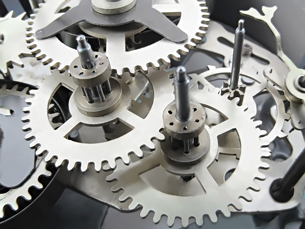Module 7—Oscillatory Motion
 Reflect and Connect
Reflect and Connect

© Samsonov Juri/shutterstock
The electrical force applied to a small, precisely shaped quartz crystal causes it to oscillate (bend back and forth). The electrical signal matches the resonant frequency of the crystal, causing it to oscillate with maximum amplitude. This mechanical resonance is used to generate an electrical signal that can drive the gears in an analog wristwatch or drive the electrical signals in a digital wristwatch. Whether analog or digital, the principles of mechanical resonance are used to keep accurate time. With many millions of timekeeping devices all over the world, it is easy to understand how your entire existence can be scheduled and coordinated with other organizations and people. In order for this to be effective and useful, the multitudes of timekeeping devices all over the planet need to be synchronized.
When the power to your house is interrupted during a storm, for example, all the clocks need to be reset to the current time. Where does this current time come from? Recall your work with global positioning satellites, which are based on accurate synchronization of time signals. Is there a “master clock” by which all other clocks on the planet are synchronized? What kind of clock is the most accurate on the planet? Do a quick Internet search for atomic clocks, and try to find out about the “master clock.” Consider how important this clock is to our civilization and if resonance plays a role in its operation.
 Discuss
Discuss

© Joseph Becker/shutterstock
The original Tacoma Narrows suspension bridge in Washington state was constructed in 1940. It lasted four months before self-destructing in dramatic fashion. Engineers had failed to consider mechanical resonance in the design. View the destruction of the bridge in the video resonance in bridges.
Was the Tacoma Narrows Bridge a very large musical instrument? In the discussion forum, explain why the bridge was destroyed and how scale models are used to test resonance effects in building and bridge structures.
 Reflect on the Big Picture
Reflect on the Big Picture
Each of the Reflect on the Big Picture sections in this module will help you reinforce your learning about oscillation. Complete the concept map in “Conceptual Overview” on page 389 of the textbook. Add the concept map to your Physics 20 course folder.
Complete at least one of the following reflection activities:
- Brainstorm reasons why troops don’t march across bridges but, rather, just walk. Look up your ideas on the Internet. Choose your top two ideas, and list them along with the URLs of websites that convinced you to rate them in your top two websites.
- You are playing some of your favourite music when it keeps getting interrupted with a buzzing somewhere in your listening room. What is happening? How can you explain it? Draw or paint a poster to show your situation, and explain the cause.
- Create a timeline of timepiece development. Include pictures and explanations of each development.
Store your completed reflection in your Physics 20 course folder.
 Going Beyond
Going Beyond
Just how sensitive to temperature is a common digital watch? Design and carry out an experiment to determine if changing temperatures affect the timing characteristics of the crystal in a digital watch. You will have to find a source of accurate time information and a way to vary the temperature of the watch over a long enough time to be sure of your results.
 Module 7: Lesson 3 Assignment
Module 7: Lesson 3 Assignment
Remember to submit the Module 7: Lesson 3 Assignment to your teacher.